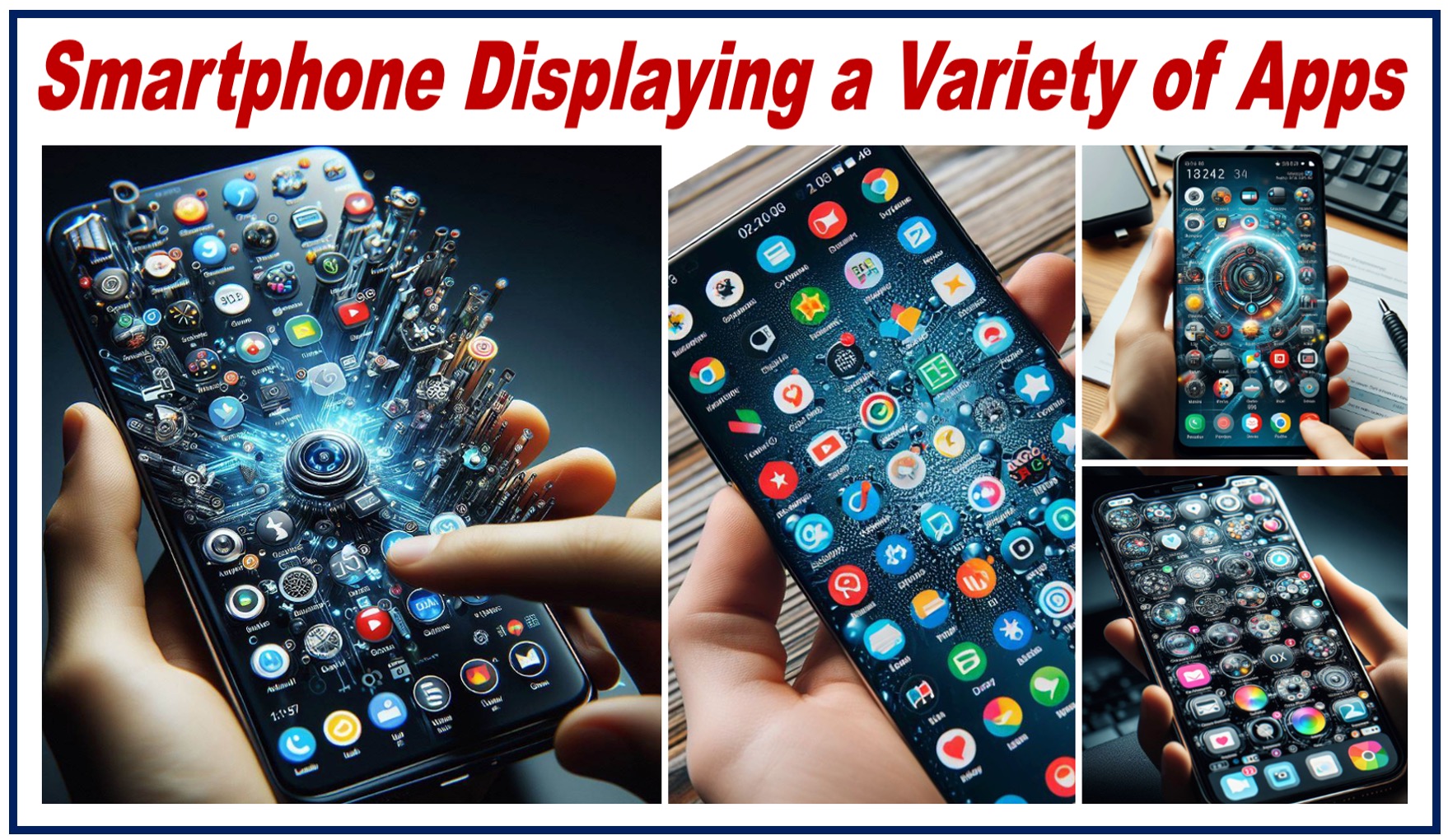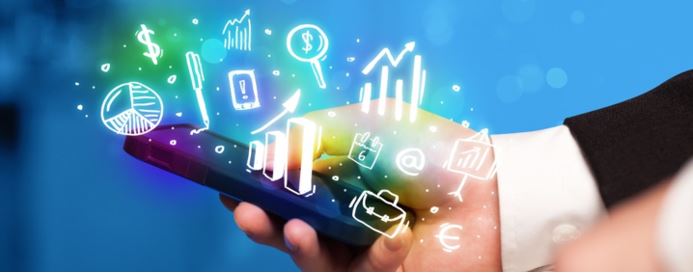What is a smartphone?
A Smartphone is a mobile phone that also has Internet access, and computing capabilities, enabling voice communication, app usage, satellite navigation, and multimedia management.
Smartphones have a touch-screen interface, which means that users interact with the device through touch gestures such as tapping, swiping, and pinching on the screen, instead of using physical buttons or a keyboard.
The mobile operating system endows the device with many advanced computing features.
Smartphone operating systems
The most prevalent smartphone operating systems globally are Google’s Android and Apple’s iOS, with Huawei’s HarmonyOS also gaining significance, especially in the Chinese market.
These systems enable smartphone owners to:
- Use broadband, Wi-Fi, Bluetooth, and near-field communication (NFC).
- Browse the Internet.
- Send and receive emails.
- Download and upload files, with increased emphasis on cloud-based storage and sharing.
- Take high-resolution photographs and record high-definition videos.
- Play advanced computer games.
- Stream music and watch movies.
- Stay in touch with friends and family through text, voice, and video messaging, including on various social media platforms.
- Keep address and contact lists, calendars, to-do lists, notes, and integrate digital assistants for reminders.”
Users can also install a huge selection of applications (apps). From news gathering to finance management, apps keep users informed, productive, entertained, and organized.

New devices every year
Every year spawns new models of smartphones with more power and storage. In addition, more and more apps come on the market.
Today, people use smartphones to shop, book holidays, stream live content, connect, control their homes, and even monitor their health.
The devices are essential survival tools of modern times. It is hard to imagine life without them.
According to Statista, there are more than 3 billion smartphone users worldwide. The German data company also estimate that global production of smartphones exceeded 1.4 billion in 2018.
Evolution of the smartphone
-
Mobile phones and personal organizers
Smartphones evolved from the convergence of two devices: the cell phone and the personal organizer. In the 1990s, the two devices were separate and consumers tended to own one or the other.
-
Cameras
Over that decade, competition among networks drove down the cost of cell phones and calls. By the close of the 20th century, teenagers were using them. The addition of a camera meant that they could text their friends and attach a photo. Also, the addition of a music player meant that they did not need a separate portable stereo.
-
PDAs
In the meantime, business people were increasing their use of personal digital assistants (PDAs) such as the Palm Pilot and the Psion Organizer. PDAs allowed users to access their calendars, work on spreadsheets and documents, and use other applications on the move. Some could also synchronize their PDAs with their desktop computers.
The first device to embody telephone and PDA features was the Simon Personal Communicator from IBM.
Launched in 1994, the Simon predates the use of the term smartphone. It was years ahead of its time. Not only did it work as a phone, it also provided email, calendar, contacts, calculator, notepads, and fax services.
-
ARM and 3G
It was the convergence of the ARM microprocessor and the 3G mobile network that spurred the smartphone revolution.
ARM microprocessors made it possible for a small device to run a lot of computing power on little energy. Acorn Computers launched the first chip for the mass market in 1985.
The advent of 3G allowed networks to send data at much higher rates. This opened the door to sending and receiving video and multimedia. With the arrival of 4G in 2012 and of 5G, the data-carrying capacity continues to grow.
In addition, developers have added features such as touch screens and navigation with the Global Positioning System (GPS).

The case for smartphone recycling
The increasing use of smartphones is putting a strain on Earth’s resources. Researchers at the University of Plymouth in the United Kingdom demonstrated this by analyzing the chemical make-up of the devices. They blended phones to dust and carried out an analysis of the dissolved results.
The team found that, among other substances, a smartphone contains 33 grams (g) of iron, 13 g of silicon, and 7 g of chromium.
They also found smaller quantities of silver (90 milligrams or mg) and gold (36 mg), and other critical elements, including:
- 900 mg of tungsten.
- 160 mg of neodymium.
- 70 mg of cobalt and molybdenum
- 30 mg of praseodymium.
The results show that to make just one smartphone it is necessary to mine 10-15 kilograms (kg) of ore. Of this ore, some 7 kg is high-grade gold, 1 kg of copper, 750 kg of tungsten, and 200 g of nickel.
The researchers carried out the experiment to highlight the rare elements that each phone contains and to promote greater recycling. Some of the elements, such as tungsten and cobalt, come from conflict zones in Africa.
Manufacturers are increasingly focusing on sustainable production methods and the use of recycled materials to mitigate the environmental impact of smartphone manufacturing.
Smartphone vocabulary and concepts
It is amazing to think that not that many decades ago, if you had uttered the word “smartphone,” nobody would have understood what you were talking about. Now, smartphone-related vocabulary is extensive.
Let’s look at some compound phrases that contain the word “smartphone,” understand their meanings, and see how we use them in a sentence:
-
Smartphone adoption
The process by which consumers start to use smartphones.
Example: “Smartphone adoption has skyrocketed in the past decade, with nearly every adult owning one.”
-
Smartphone capabilities
The functions and features that a smartphone can perform.
Example: “The latest model has expanded smartphone capabilities, including augmented reality and AI-powered photography.”
-
Smartphone integration
The process of incorporating smartphone technology with other systems and devices.
Example: “Smartphone integration in modern vehicles allows drivers to use navigation apps through the car’s display.”
-
Smartphone penetration
The extent to which smartphones are used within a particular market or demographic.
Example: “Smartphone penetration in the region has reached over 90%, according to the latest survey.”
-
Smartphone dependency
The reliance of individuals on their smartphones for daily activities.
Example: “The study revealed a growing trend of smartphone dependency among young adults for both work and leisure.”
-
Smartphone etiquette
The customary code of polite behavior in society or among members of a particular profession or group regarding smartphone use.
Example: “Companies are increasingly instituting smartphone etiquette guidelines to ensure meetings are free from digital distractions.”
What does “smart” mean
A “smart” device is an electronic device that is able to connect, interact, and share data with other smart devices. Smart devices are “cleverer” than their traditional counterparts.
Today, there are many smart devices. Let’s have a look at some of them:
-
Smartphones
As explained in this article.
-
Smart TVs
Televisions that connect to the internet to stream digital content, use apps, and sometimes offer voice and gesture control.
-
Smart Air Purifiers
Automatically adjust filtering based on air quality and can be controlled remotely.
-
Smart Doorbells
Feature video and intercom systems for remote visitor interaction.
-
Smart Fridges
Monitor food inventory, suggest recipes, and sometimes allow grocery shopping.
-
Smart Home Security Systems
Provide home monitoring and alerting services through connected sensors and cameras.
-
Smart Homes
Integrate various smart devices for centralized control of the home environment.
-
Smart Lights
Allow remote control of lighting, including color and intensity adjustments.
-
Smart Locks
Enable keyless entry and remote access control via mobile devices.
-
Smart Thermostats
Adjust home temperature based on behavior patterns and can be controlled remotely.
-
Smart Vacuums (Robot Vacuums)
Clean floors autonomously and can be scheduled or activated through smartphones.
-
Smart Vehicles
Incorporate internet connectivity for various functions like navigation, remote diagnostics, and entertainment.
-
Smart Wearables
Track health and fitness metrics while offering notifications and other phone-linked features.
2 Educational Videos
These two videos come from our sister channel in YouTube – Marketing Business Network. One is about “Smartphones” and the other explains what “Smart” means when we’re talking about electronic devices. They both use easy-to-understand language and examples.
-
What is a Smartphone?
-
What is Smart?

